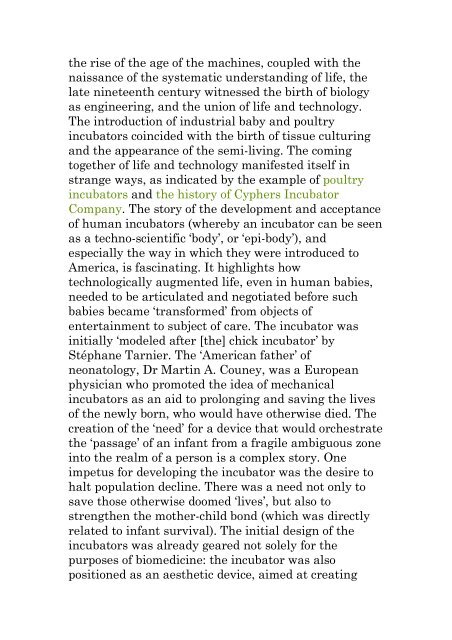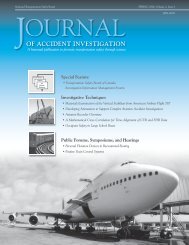The Semi-Living' and 'Partial Life'
The Semi-Living' and 'Partial Life'
The Semi-Living' and 'Partial Life'
Create successful ePaper yourself
Turn your PDF publications into a flip-book with our unique Google optimized e-Paper software.
the rise of the age of the machines, coupled with the<br />
naissance of the systematic underst<strong>and</strong>ing of life, the<br />
late nineteenth century witnessed the birth of biology<br />
as engineering, <strong>and</strong> the union of life <strong>and</strong> technology.<br />
<strong>The</strong> introduction of industrial baby <strong>and</strong> poultry<br />
incubators coincided with the birth of tissue culturing<br />
<strong>and</strong> the appearance of the semi-living. <strong>The</strong> coming<br />
together of life <strong>and</strong> technology manifested itself in<br />
strange ways, as indicated by the example of poultry<br />
incubators <strong>and</strong> the history of Cyphers Incubator<br />
Company. <strong>The</strong> story of the development <strong>and</strong> acceptance<br />
of human incubators (whereby an incubator can be seen<br />
as a techno-scientific ‘body’, or ‘epi-body’), <strong>and</strong><br />
especially the way in which they were introduced to<br />
America, is fascinating. It highlights how<br />
technologically augmented life, even in human babies,<br />
needed to be articulated <strong>and</strong> negotiated before such<br />
babies became ‘transformed’ from objects of<br />
entertainment to subject of care. <strong>The</strong> incubator was<br />
initially ‘modeled after [the] chick incubator’ by<br />
Stéphane Tarnier. <strong>The</strong> ‘American father’ of<br />
neonatology, Dr Martin A. Couney, was a European<br />
physician who promoted the idea of mechanical<br />
incubators as an aid to prolonging <strong>and</strong> saving the lives<br />
of the newly born, who would have otherwise died. <strong>The</strong><br />
creation of the ‘need’ for a device that would orchestrate<br />
the ‘passage’ of an infant from a fragile ambiguous zone<br />
into the realm of a person is a complex story. One<br />
impetus for developing the incubator was the desire to<br />
halt population decline. <strong>The</strong>re was a need not only to<br />
save those otherwise doomed ‘lives’, but also to<br />
strengthen the mother-child bond (which was directly<br />
related to infant survival). <strong>The</strong> initial design of the<br />
incubators was already geared not solely for the<br />
purposes of biomedicine: the incubator was also<br />
positioned as an aesthetic device, aimed at creating

















